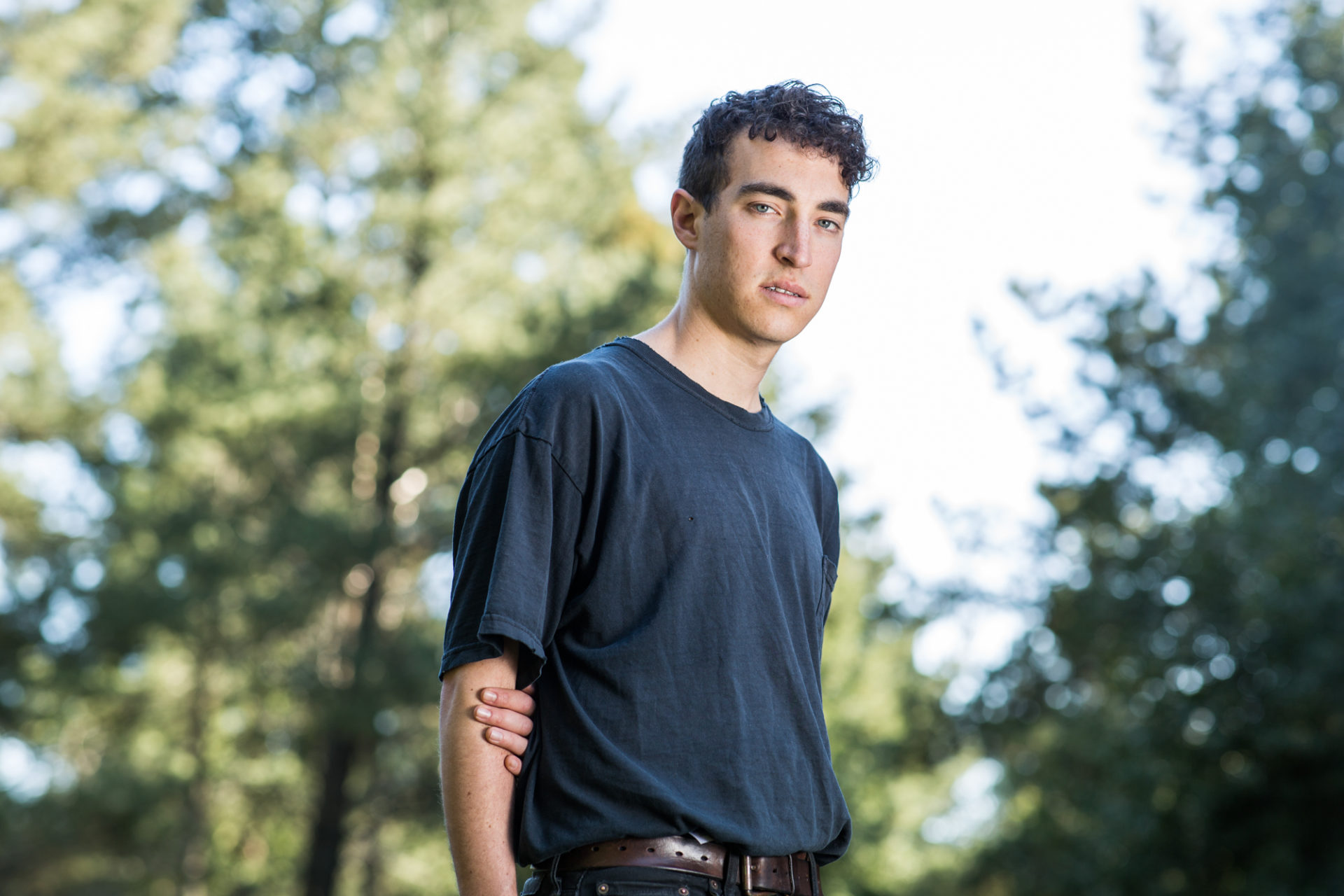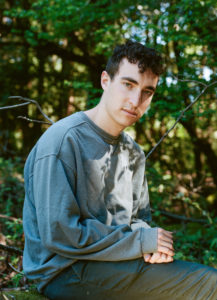
It’s rare to find songs as and spare and beautifully haunting as those on “A Palace in Time” by Abe Hollow, a musical project by Oakland singer-songwriter Adam Hirsch. The collection of moody, ethereal tunes was released in July.
Hirsch, 26, also produces and plays several instruments. He’s been practicing with local musicians to prep for a tour in support of the album later in the summer. To listen to his songs or to learn more about the musical artist, go online here or here.
Local News Matters recently chatted by phone with Hirsch. A Q&A based on that interview appears below. It includes Hirsch’s thoughts on how his family’s complicated history inspired his record’s themes and fueled his inventive songwriting. Part of the Q&A has been edited for space and clarity.
What has been the biggest influence on your songwriting?
In my songs, I tend to write about family history; the mythology within the history of my family, whether it’s real or imagined. The stories I tell take place in Los Angeles because my family has lived there a long time. L.A. has been an interesting framework in which to craft my music, even though I don’t live there anymore.
I’m imagining histories that were there long before I got there. To a certain extent, L.A. influences me. I’m still digging into it, as a site where my family history has played out, amid a larger context, in terms of our Jewishness and the Jewish diaspora.
So, your family history is your main source of inspiration?
Not singularly, but it definitely plays a large role. Definitely a large part of the record for me was a kind of obsession with the mythology of identity and the various ways we derive our mythology, by looking at my family history and the stories within.
For me, the biggest story is the Jewish diaspora. It took shape in a number of ways. Some of it involved very specific histories. I dig into the story of my great-grandfather. The project is named after him. He’s my namesake: Abe.
You produced and wrote all the songs on your new album, “A Palace in Time.” I was especially drawn to the song, “Papa.”
“Papa” is about my great-grandfather. I see Los Angeles as this far corner, this far western reach of the Jewish diaspora. It’s far, geographically, from the rest of the Jewish people in the U.S. and across the globe. I like imagining that history and that effort as something kind of crazed and ongoing, in a really complicated way. And I think I’ve come to see my life as part of this narrative.
There is a particular diasporic moment happening now in the globe, it’s something that’s very troubled. I don’t see it as a moment where we’re flourishing or that we’re where we need to be. There’s a lot of complication and a lot of bad stuff that’s happening.
How does your great-grandfather fit into the album?
I tell these contradictory and inspiring parts of his personality. He was driven by this idea of figuring out a way for my family to be secure, but by taking huge risks.
He was constantly buying land in L.A. and in the desert, but he was often failing. He was obsessed with the desert. He became close friends with a Navajo tribe in the 1940s or 1950s. They repeatedly invited him to their sweat lodges and to take peyote with them. Lots of people in my family had crazy wild-eyed ideas, a lot of that involved moving west and doing something different and distinct.
It was a bumpy ride and it ended up with lots of chaos with my family in a lot of ways. I get excited-slash-obsessed with those stories and how they fit into my life. In my songs, they become these half-imagined histories and I tell these stories in ways that fit into fiction or my imagination. They blend with whatever acoustical environment is happening in any song, as I’m creating some kind of imagined narative.
What brought you to Oakland?
I came here to get an MFA degree at Mills College in Oakland. By the time I graduated, I had a great community of musicians here. I was working at Tiny Telephone Recording music studio. Since then, all of that has continued to keep me rooted here, my music community has grown since then.
What instruments do you play?
I originally played saxophone and clarinet. My more recent instruments are guitar, synthesizer, and keyboards. I also do vocals. I write all my songs on guitar. In terms of the instruments I play on this album, I spread myself out.
How did you start as a musician?

I picked up a clarinet when I was 9 because all my friends were joining the band in elementary school. My parents rented a clarinet for me. I immediately latched onto it. I got excited over what it felt like to make sounds. It felt profound to me from the first moment I played.
When I learned to play melodies and could move the notes around, I remember having a distinct feeling of, “Wow, I’m making something.” My relationship to music can still be characterized by that feeling. I think I’m chasing that feeling most of the time.
Who were your musical influences when you were just starting?
I was very heavily into jazz. I was trained as a jazz musician on the sax. I was obsessed with John Coltrane and Thelonious Monk. Early on, I latched onto Wilco, a lot of Beck, a lot of Radiohead. In middle school and high school, that felt really important to me.
The bands I got into are people who are very excited about integrating totally weird shit into their songwriting. All three of those groups, especially Wilco, embrace noise and experimentation in a way that continues to be really inspire me. Also, Arthur Russell (a versatile musician, songwriter, and singer who thrived in New York in the 1970s and 1980s) was a major influence.
Did you have an original concept for this album?
It was not a planned concept. It unfolded from the pool of songs I was writing. The recording process happened at a tumultuous time of my life. There were lots of transitions happening.
I thought really hard about the concept of crossing thresholds, what it was like to exist in liminality, a sort of in-between state. I thought about that in a historical context, the concept of diaspora. The concept of Jewish identity across time means to exist in an “in-between-ness.”
I got obsessed with the Exodus, which pops up sometimes on the record; and with European Jewish history, with migration to the U.S., which led me to exploring early Jewish history in L.A. and neighborhoods like Boyle Heights. I’m exploring transitions and asking, what kind of stories and myths can I pull from my people’s history to give me some context?
What fueled your choice to include Yiddish on the album?
During this time period when I was writing, I was trying to learn Yiddish at The Jewish Community Center of the East Bay in Berkeley. It’s part of a larger project for me to dig into diaspora history and dig out historical aspects of my identity, and to get familiar with it.
I failed pretty miserably in learning the language. It was difficult, but I became obsessed with it — the language and the sounds and the emotive part of it and what it actually symbolizes about the diaspora. The Yiddish language really united people — for example, the Ashkenazi Jews that lived all across Europe over a period of time. There’s something heartbreaking and sad (about the fact) that Yiddish has almost disappeared across the face of the earth. Most ascribe that to Hitler and genocide, but it was also those efforts toward assimilation that happened across Europe.
My grandparents speak Yiddish, but within the next couple of decades we’re going to lose it. It feels like a fraught thing. (The survival of) Yiddish is hanging by this thread and, in some ways, it feels like it’s not even about the language, it’s about preserving a fragment of history that’s important to us. One of my friends decided to take the full dive and become fluent, which was very inspiring to me. I wanted to integrate that into the record. I decided, “Wow, these words are powerful.” I didn’t want to present them in a naked way. The words are articulated clearly but through a language that almost nobody understands.
It seems to fit seamlessly.
I love the idea of the (listener’s) question of what this language is, to lead them into a whole new line of thought by digging into history. I love that these words that I feel vulnerable about can hide behind this dying language. Some people will understand it.
I also love that spreading out the Yiddish among the songs helps to state the album’s purpose: Trying to think very hard about the mythology of what has led me to this moment and time. To have that narrated by a Yiddish speaker feels bizarrely appropriate. It was freeing for me to write about this feeling of liminality, the mystery of transition, and all the various histories I’m trying to hold together as I move through them.
Musically speaking, how did you accomplish that?
As I constructed the sound of the pieces, I brought in a bunch of different improviser friends of mine, gave them a pair of headphones, and played for them this whole recording of my friend reading this passage in Yiddish. And I had them improvise some music for each. I ended up with this trove of sound, of music. What they generated came from a pure sonic context because none of them spoke Yiddish.
So, the sonic component of Yiddish is a really important aspect of the whole thing for me. Beyond the symbology and meaning of the music, the sonic component is what matters.
What’s next for you and Abe Hollow?
We start a seven-week U.S. tour in August. I’ve been rehearsing with a full band to play these songs live. We practice in a studio in Oakland’s Uptown neighborhood.
How does living and playing in The Town influence your music?
I feel very inspired by the music community in the East Bay. There’s a collective underground ethos in the East Bay that’s inspiring. There’s a thriving community of house venues and DIY spaces. Also, there are a lot of committed people making really committed music, a lot of people that are dedicated to music as a community-driven force rather than a commodity-driven force.
I’m always straddling two different musical worlds: songwriting and band. I’ve been firmly in both of those communities for a long time now, the state of both types of music is thriving, as far as how creative those communities are. This record was a product of both of those communities. My album was definitely inspired by people doing both of those things.
The people who played on the record, lots of people who are session musicians and in a band. But there are also a lot of people in the Mills community, in the experimental music community, and there are avant-garde musicians and improvisers. It was a joy for me to bring all of those people together. Those collaborations were, by far, the most rewarding part of it for me.